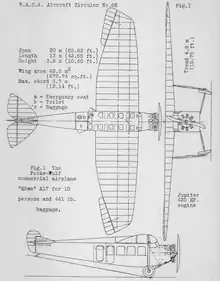Focke-Wulf A 17 Möwe
The Focke-Wulf A 17 Möwe (German: "Gull") was an airliner built in Germany in the late 1920s. It was a conventional high-wing cantilever monoplane with fixed tailwheel undercarriage. The aircraft provided fully enclosed seating for up to eight passengers and had a separate, fully enclosed flight deck for the two pilots. Most examples flew with Deutsche Luft Hansa, serving until around 1936. In the early 1930s, two A 17s were used for testing the Junkers Jumo 5 diesel engine.

| A 17 Möwe | |
|---|---|
 | |
| Role | Airliner |
| Manufacturer | Focke-Wulf |
| First flight | 1927 |
| Primary user | Deutsche Luft Hansa |
| Number built | 20 |
In 1929, an example was built with a BMW VI engine and fitted out for aerial photography and survey work and designated A 21. The cabin was equipped with a darkroom. Later the same year, the BMW engine was used on a further five airliners for Luft Hansa, these being designated A 29.
Variants
- A 17 - Eight-passenger airliner powered by 420 hp (310 kW) Gnome et Rhône 9Aa Jupiter. One prototype and 11 production aircraft.[1]
- A 17a - Conversion of A 17 with 480 hp (360 kW) geared Siemens Jupiter VI engine.[2]
- A 17b - Conversion with Siemens Sh 20u engine. One converted.[3]
- A 17c - Conversion with 520 hp (390 kW) Junkers Jumo 5C diesel engine. One converted.[3]
- A 21 Photomöwe - Photographic fitted with BMW VI engine (two built)
- A 26 - Converted A 17 used as an experimental aircraft by Deutsche Versuchsanstalt für Luftfahrt (DVL).[3]
- A 29 - production version of A 17 with BMW VI engine. Five built.[4]
Specifications (A 17a)

Data from European Transport Aircraft since 1910[1]
General characteristics
- Crew: two
- Capacity: eight passengers
- Length: 14.63 m (48 ft 0 in) (tail up)
- Wingspan: 20.00 m (65 ft 7 in)
- Wing area: 62.5 m2 (673 sq ft)
- Empty weight: 2,450 kg (5,401 lb)
- Gross weight: 4,000 kg (8,818 lb)
- Powerplant: 1 × Siemens Jupiter VI , 360 kW (480 hp)
Performance
- Maximum speed: 201 km/h (125 mph, 109 kn)
- Cruise speed: 167 km/h (104 mph, 90 kn)
- Range: 800 km (500 mi, 430 nmi)
- Service ceiling: 4,500 m (14,800 ft)
See also
Aircraft of comparable role, configuration, and era
References
- Stroud 1966, p. 265–256
- Stroud 1966, p. 266
- Stroud Aeroplane Monthly & January 1987, p. 43
- Stroud 1966, pp. 268–269
| Wikimedia Commons has media related to Focke-Wulf A 17. |
- Stroud, John (1966). European Transport Aircraft since 1910. London: Putnam.
- Stroud, John (January 1987). "Wings of Peace". Aeroplane Monthly. Vol. 15 no. 1. pp. 40–45. ISSN 0143-7240.
- Taylor, Michael J. H. (1989). Jane's Encyclopedia of Aviation. London: Studio Editions. pp. 394–95.
- World Aircraft Information Files. London: Bright Star Publishing. pp. File 894 Sheet 28.
- "1928 Berlin Aero Show". Flight: 917. 18 October 1928. Retrieved 2008-03-22.
- German aircraft between 1919 and 1945